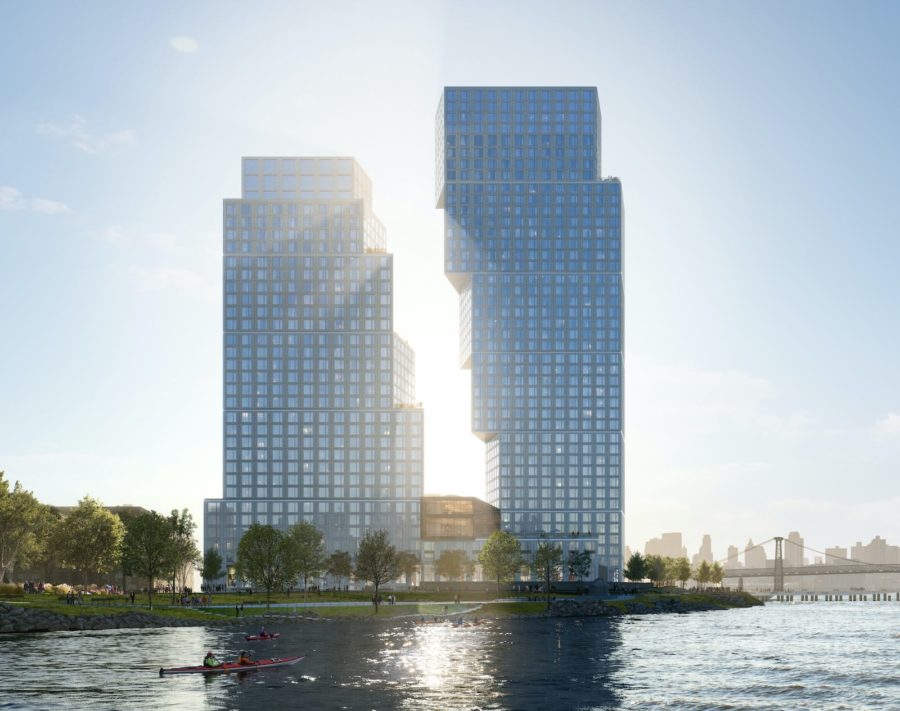さいたま市鹿手袋地区。建ち並ぶマンションの狭間の少し懐かしい街角で、八百屋や豆腐売りの声が響き門を構えた屋敷が今でも残る。子供やお年寄りが歩いていて、人と人の距離感がほどよい町だ。この場所の親しみやすさを、14世帯の入る長屋に取り込みたいと考えた。
この長屋は共用空間を持たず、テラスや庭などもすべて各住戸の専有空間となっている。そのため、住人は自分のテーブルや椅子や植物を建物の外に気軽に出しておける。だから、住人の姿が直接見えなくても、さまざまな家具や植栽が建物の外観に散りばめられ、生活風景が街並みに溶け込んでいる。専有部分という空間の輪郭をつくることで、人はプライベートが守られる安心感を感じ、だからこその意識を外の空間へと向ける余裕を持つことができる。「閉じることで開く」建築といえる。
建物の構成としては、敷地いっぱいに配置したボリュームを、東西と南北に抜ける細長いヴォイドによって縦横に分割している。ヴォイドは建物を貫通し街路や隣地の緑へと繋がるので、入り組んだ建物の奥からでも隣人や街の気配が感じられる。格子状に細分化されたコンクリートの建物の中には、複雑に絡む14種類の住戸が立体的に計画され、隣棟とバッティングすることを避けた開口部から光と風が住戸内に導かれる。
竣工から8年目を迎え、住人たちの生活風景はこの街に定着し、長屋と街が地続きになっている。長屋の竣工後に、長屋と同じオーナーによる古い蔵の改修や、マンションの1室の改修が相次いで行われ、鹿手袋の町の中で面的な広がりも見せている。1つの建物から、人々が暮らす小さな街区へと、設計対象は広がっている。(藤野高志)
The architecture resembles a city block with a grid of 14 units with private gardens
In the Shikatebukuro district of Saitama City, there are still houses with gates that echo with the voices of grocery stores and tofu sellers on a slightly nostalgic street corner between the rows of apartment buildings. It is a town where children and elderly people walk around, and the distance between people is comfortable. I wanted to incorporate the familiarity of this place into a row house that would house 14 families.
This row house has no common space, and all the terraces and gardens are private to each unit. Therefore, the residents can feel free to leave their tables, chairs, and plants outside the building. So, even if the residents are not directly visible, various furniture and plants are scattered around the exterior of the building, and the living scenery blends into the cityscape. By creating an outline of space in the form of private areas, people feel a sense of security that their privacy is protected, and for this reason, they can afford to direct their awareness to the outside space. Thus, it is an architecture that opens by closing.
The building comprises a volume that fills the entire site and is divided horizontally and vertically by long, narrow voids that run east-west and north-south. The voids penetrate the building and connect to the street and the greenery of the neighboring land so that the presence of the neighbors and the city can be felt even from the depths of the intricate building. Within the concrete building subdivided into lattices, fourteen different units are intricately planned in a three-dimensional manner. Light and wind are directed into the units through openings that avoid clashing with neighboring buildings.
Eight years have passed since the completion of the project, and the residents’ lifestyle has become a part of the town, and the row houses and the town have become connected. From a single building to a small district where people live, the subject of the design has expanded. (Takashi Fujino)
【鹿手袋の長屋】
所在地:埼玉県さいたま市南区
用途:共同住宅・集合住宅
クライアント:望月陽子
竣工:2014年
設計:生物建築舎
担当:藤野高志、森田達也
構造設計:ASA
サイン:マニアッカーズデザイン
植栽:田中園SHOP
施工:橋詰工業
撮影:生物建築舎
工事種別:新築
構造:RC造
規模:地上3階
敷地面積:706.77m²
建築面積:383.52m²
延床面積:751.34m²
設計期間:2011.09-2013.02
施工期間:2013.03-2014.07
【SHIKATEBUKURO APARTMENT】
Location: Minami-ku, Saitama-shi, Saitama, Japan
Principal use: Housing Complex
Client: Yoko Mochizuki
Completion: 2014
Architects: IKIMONO ARCHITECTS
Design team: Takashi Fujino, Tatsuya Morita
Structure engineer: ASA
Sign: Maniackers Design
Plant: Tanakaen
Contractor: Hashizume Kogyo
Photographs: IKIMONO ARCHITECTS
Construction type: New Building
Main structure: Reinforced Concrete construction
Building scale: 3 stories
Site area: 706.77m²
Building area: 383.52m²
Total floor area: 751.34m²
Design term: 2011.09-2013.02
Construction term: 2013.03-2014.07








